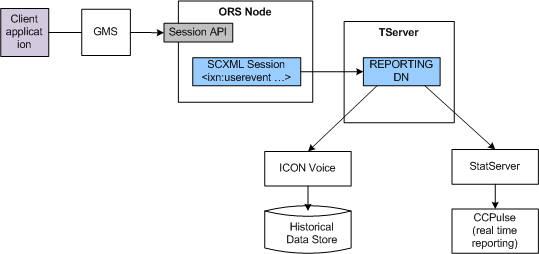Contents
Custom Reporting
Basic Configuration for Real-Time and Historical Reporting Based on T-Server's UserEvent Mechanism
Prerequisites
- ORS is connected to T-Server
- StatServer is connected to the same T-Server (if you need real-time reporting)
- Icon is connected to T-Server and configured to store user events to G_CUSTOM_DATA_P table (if you need historical reporting)
Architecture
Configuration Instructions
1. Create a new DN of type Extension. The name of the DN is not important, but it is used inside SCXML scripts so it should be meaningful and recognizable.
Example: Sip_Switch -> DN -> REPORTING
2. Make sure Icon and StatServer are connected to the T-Server that is servicing the switch specified in step 1.
Example: Sip_Server.
3. In Icon configuration in Configuration Manager, add the 'custom-states' section under Options and create the GlobalData option there. List attached data fields you want to capture preceded with data type.
Example:
custom-states/GlobalData=char,gms_SessionId, char,gms_SessionEventSeq, char,gms_ServiceName, char,gms_UserId, char,gms_externalId,
char,gms_ServiceStartAt, char,gms_WaitingForAgent, char,gms_AgentAvailable, char,gms_UserConnected,
char,gms_AgentConnected, char,gms_IxnCompleted, char,gms_ServiceStoppedAt
4. Start Icon and StatServer (if not already started) and use logs to verify they registered on REPORTING DN.
5. Add the following block of code to the beginning of your SCXML flow. This code will set up the _data.userevent_udata_to_send variable to store all significant state changes you want to capture from the point of view of reporting. Names should match Icon's GlobalData configuration option and StatServer/CCPulse reporting and statistics templates.
Example:
<datamodel>
</datamodel>
<script>
_data.userevent_udata_to_send = {
'gms_SessionId':_sessionid,
'gms_SessionEventSeq':0,
'gms_ServiceName':'your service name here',
'gms_UserId':,
'gms_externalId':,
// service state change timestamps
'gms_ServiceStartAt': ,
'gms_WaitingForAgent':,
'gms_AgentAvailable':,
'gms_UserConnected':,
'gms_AgentConnected':,
'gms_IxnCompleted':,
'gms_ServiceStoppedAt':
};
</script>
6. Add the following block of code into your SCXML flow where significant state change is happening:
<script>
_data.userevent_udata_to_send.gms_WaitingForAgent = new Date().getTime().toString();
_data.userevent_udata_to_send.gms_SessionEventSeq = _data.userevent_udata_to_send.gms_SessionEventSeq + 1;
</script>
<ixn:userevent requestid="_data.userevent_reqid" resource="({'switch':'SIP_Switch', 'dn':'REPORTING'})"
udata="_data.userevent_udata_to_send"/>
Example:
<state id="waitForAgent">
<onentry>
<script>
_data.userevent_udata_to_send.gms_WaitingForAgent = new Date().getTime().toString();
_data.userevent_udata_to_send.gms_SessionEventSeq = _data.userevent_udata_to_send.gms_SessionEventSeq + 1;
</script>
<ixn:userevent requestid="_data.userevent_reqid" resource="({'switch':'SIP_Switch', 'dn':'REPORTING'})"
udata="_data.userevent_udata_to_send"/>
<queue:submit route="false" timeout="_data.queueSubmitTimeout">
<queue:targets type="agentgroup">
<queue:target name="_data.defaultAgentGroup"/>
</queue:targets>
</queue:submit>
</onentry>
<transition event="queue.submit.done" target="agentAvailable"/>
<transition event="error.queue.submit" target="error">
</transition>
<transition event="service.ttl.expired" target="error">
</transition>
</state>
Verifying Reporting Data
- Run your scenario by triggering Genesys Mobile Services and Orchestration Server (ORS) APIs directly.
- Make sure user events are being delivered to StatServer and Icon applications by checking T-Server logs. You should see something like this:
00:34:20.757 Int 04543 Interaction message "RequestDistributeUserEvent" received from 516 ("OrchestrationServer")
-- Absent ThisDN, REPORTING was used
@00:34:20.7570 [0] 8.1.000.62 send_to_client: message EventACK
AttributeEventSequenceNumber 0000000000000ef8
AttributeCustomerID 'Environment'
AttributeTimeinuSecs 757000
AttributeTimeinSecs 1348817660 (00:34:20)
AttributeReferenceID 431
AttributeThisDN 'REPORTING'
AttributeUserEvent RequestDistributeUserEvent
00:34:20.757 Trc 04542 EventACK sent to [516] (00000003 OrchestrationServer 192.168.27.50:40727)
@00:34:20.7570 [0] 8.1.000.62 distribute_user_event: message EventUserEvent
AttributeEventSequenceNumber 0000000000000ef9
AttributeCustomerID 'Environment'
AttributeTimeinuSecs 757000
AttributeTimeinSecs 1348817660 (00:34:20)
AttributeUserEvent EventUserEvent
AttributeUserData [347] 00 0c 00 00..
'gms_AgentAvailable' '1348817660755'
'gms_AgentConnected'
'gms_IxnCompleted'
'gms_ServiceName' 'inbound-delay'
'gms_ServiceStartAt' '1348817660553'
'gms_ServiceStoppedAt'
'gms_SessionEventSeq' 3
'gms_SessionId' '65UA6ISSJH76R340BNDQ2DG0DG000036'
'gms_UserConnected'
'gms_UserId'
'gms_WaitingForAgent' '1348817660744'
'gms_externalId'
AttributeANI '777'
AttributeDNIS '333'
AttributeReferenceID 431
AttributeThisDN 'REPORTING'
00:34:20.758 Trc 04542 EventUserEvent sent to [508] (0000000c Icon_Voice 192.168.27.50:42678)
00:34:20.758 Trc 04542 EventUserEvent sent to [588] (00000004 Stat_Server 192.168.27.50:40728)
00:34:20.758 Trc 04542 EventUserEvent sent to [592] (00000005 Universal_Routing_Server 192.168.27.50:40744)
3. Check your Icon log and G_CUSTOM_DATA_P table and make sure data is recorded properly.
Examples:
Icon log:
00:39:19.569 Int 04543 Interaction message "EventUserEvent" received from 65200 ("SIP_Server@REPORTING")
00:39:19.751 Int 04543 Interaction message "EventUserEvent" received from 65200 ("SIP_Server@REPORTING")
00:39:19.766 Int 04543 Interaction message "EventUserEvent" received from 65200 ("SIP_Server@REPORTING")
00:39:19.987 Trc 25016 Persistent Queue GUD: transaction 10929 is committed. 5 records written into the queue
00:39:19.987 Trc 25003 Database queue [GUD]: persistent queue transaction 10929 is being processed.
00:39:20.001 Trc 25004 Database queue [GUD]: persistent queue transaction 10929 is processed, committed and removed. 5 records are written.
Icon's G_CUSTOM_DATA_P table:
select * from dbo.G_CUSTOM_DATA_P 8 0 830 REPORTING 0 101 1 2012-09-28 07:43:09.443 1348818189 4496060 65UA6ISSJH76R340BNDQ2DG0DG000038 1 inbound-delay 1348818189441 9 0 830 REPORTING 0 101 1 2012-09-28 07:43:09.590 1348818189 4496060 65UA6ISSJH76R340BNDQ2DG0DG000038 2 inbound-delay 1348818189441 1348818189590 10 0 830 REPORTING 0 101 1 2012-09-28 07:43:09.600 1348818189 4496060 65UA6ISSJH76R340BNDQ2DG0DG000038 3 inbound-delay 1348818189441 1348818189590 1348818189596
4. Start CCPulse and create a reporting template for monitoring REPORTING DN. If you request the following statistic with time-profile below, it will start accumulating the value of the given key in user-data of your user-events.
[TotalCustomValue_UserEvent] Category=TotalCustomValue Objects=RegDN,Agent,Place,GroupAgents,GroupPlaces MainMask=UserEvent Subject=DNAction Formula=GetGlobalNumber( "<your key>" ) [TimeProfiles] Sel2,Selection=2
Congratulations: you are done!

